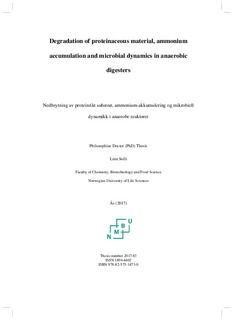| dc.contributor.advisor | Horn, Svein Jarle | |
| dc.contributor.advisor | Schnürer, Anna | |
| dc.contributor.advisor | Bergersen, Ove | |
| dc.contributor.author | Solli, Linn | |
| dc.date.accessioned | 2018-05-24T10:41:29Z | |
| dc.date.available | 2018-05-24T10:41:29Z | |
| dc.date.issued | 2017 | |
| dc.identifier.isbn | 978-82-575-1473-0 | |
| dc.identifier.issn | 1894-6402 | |
| dc.identifier.uri | http://hdl.handle.net/11250/2499080 | |
| dc.description.abstract | Anaerobic digestion (AD) of organic material from Norwegian farms can contribute to the agricultural value chain. Agricultural waste, including animal manure, is in large supply in Norway and AD of these fractions can reduce carbon emission, provide energy in the form of methane, and increase recovery of nutrients. To make AD cost effective in Norwegian agriculture, process optimization and high methane yields are necessary. One way to increase energy yields from agricultural wastes is by co digesting them with other more nutrient rich substrates like fish residues. Such substrates contains considerable amounts of energy rich fat and protein, and thus represent high methane potentials. In addition,
coordination of organic wastes from agriculture and aquaculture could improve the sustainability and value chains in both these sectors. Moreover, co-digestion of substrates with different properties may enhance the nutrient balance and buffer capacity. During AD of fat and protein rich substrates, there is a risk for elevated concentrations of ammoniumnitrogen
and fatty acids, which inhibits the methane producing microbial community, and might cause instability and failure of the AD process. Proper adjustment of operational parameters and adaptation of the microbial community are crucial to avoid process failure during AD of energy rich substrates. The focus of this thesis was to evaluate AD process stability and methane production from energy rich organic fractions with animal manure as a co-substrate. In co-digestion trials using ensiled fish waste and cow manure, a mixing ratio of 13 % fish waste and 87 % cow manure (volume based) operated with a retention time of 30 days seemed promising with regard to stable AD process and high methane yields. The experiments also showed that the biogas process maintained stable at a retention time of 20 days, which implies that the amount of fish waste in the substrate can be increased if the amount of manure is simultaneously increased. The microbial communities involved in the AD processes were monitored and analyzed, particularly focusing on the development and establishment of ammonium tolerant microorganisms. The experiments showed that the microbial communities adapted to an increased load of proteins and fats, and that the presence of some key functioning microorganisms seemed to play important roles in these systems. | nb_NO |
| dc.description.abstract | Anaerob nedbrytning (AD) av organisk material fra norske gårder kan bidra til å bedre verdikjeden i landbruket. Avfall fra landbrukssektoren, inkludert husdyrgjødsel, er i stor tilførsel i Norge og anaerob nedbrytning av disse fraksjonene vil føre til redusert karbonutslipp, energiproduksjon i form av metan og en økt resirkulering av næringsstoffer. For å gjøre AD kostnadseffektivt i norsk landbruk er det nødvendig med prosessoptimalisering og økt metan -utbytte. En måte å øke energiutbyttet fra organisk materiale i landbruket er ved sambehandling med andre mer næringsrike substrater, for eksempel avskjær og slakteavfall fra akvakulturnæringen. Slike substrater inneholder betydelige mengder energi i form av fett og protein, og representerer derfor høye metan - potensialer. Koordinering av organisk avfall fra landbruk og akvakultur kan også bidra til å øke både bærekraft og verdikjede i de to sektorene. I tillegg vil substrater med ulike egenskaper forbedre næringsbalansen og bufferkapasiteten og dermed gi et økt metan - utbytte. Når protein og fett brytes ned anaerobt er det en risiko for opphopning av ammonium-nitrogen og fettsyrer som kan hemme metan - produserende mikrobielle samfunn og ustabilitet og kollaps av biogassprosessen kan inntreffe. Riktig justering av driftsparametere og tilpasning av mikrobielle samfunn er avgjørende for å unngå prosesskollaps under nedbrytning av energirike substrater. Fokuset i denne oppgaven var å undersøke biogassprosess-stabilitet og metan - produksjon fra energirike organiske fraksjoner i sambehandling med husdyrgjødsel. I sambehandlingsforsøk med ensilert fiskeavfall og storfegjødsel var et blandingsforhold på 13 % fiskeavfall og 87 % gjødsel (volum basert) og oppholdstid på 30 dager lovende med tanke på stabil biogassprosess og høyt metanutbytte. Forsøkene viste også at biogassprosessen forble stabil med en oppholdstid på 20 dager, og dette viser at andelen fiskeavfall i substratet kan økes hvis andelen gjødsel økes samtidig. De mikrobielle
samfunnene som er involvert i nedbrytningsprosessen ble monitorert og analysert med hovedfokus på utvikling og etablering av ammonium -tolerante mikroorganismer.Forsøkene viste at det mikrobielle samfunnet tilpasset seg økt belastning av proteiner og fett, og at enkelte nøkkel-organismer spilte en viktige roller i disse systemene. | nb_NO |
| dc.description.sponsorship | Norges Forskningsråd | nb_NO |
| dc.language.iso | eng | nb_NO |
| dc.publisher | Norwegian University of Life Sciences, Ås | nb_NO |
| dc.relation.ispartofseries | PhD Thesis;2017:83 | |
| dc.rights | Attribution-NonCommercial-NoDerivatives 4.0 Internasjonal | * |
| dc.rights.uri | http://creativecommons.org/licenses/by-nc-nd/4.0/deed.no | * |
| dc.title | Degradation of proteinaceous material, ammonium accumulation and microbial dynamics in anaerobic digesters | nb_NO |
| dc.title.alternative | Nedbrytning av proteinrikt substrat, ammonium-akkumulering og mikrobiell dynamikk i anaerobe reaktorer | nb_NO |
| dc.type | Doctoral thesis | nb_NO |

